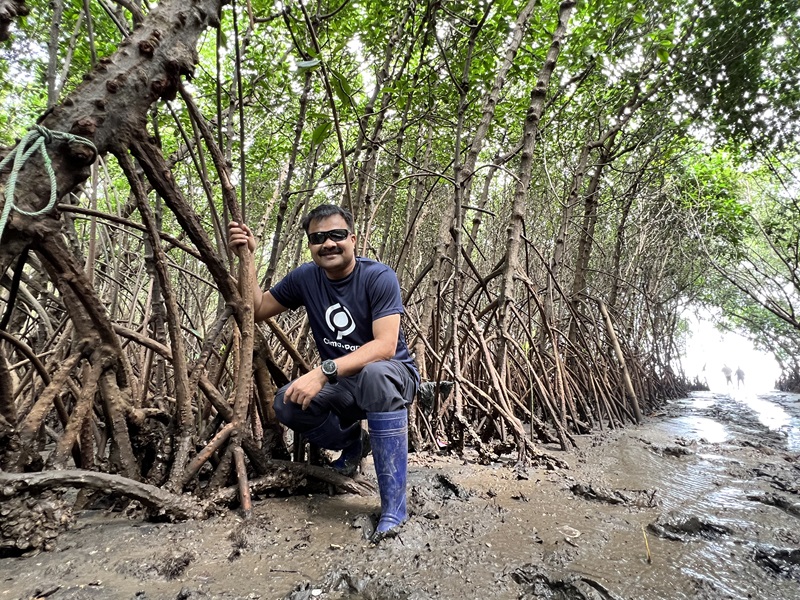Hardy, adaptable, and a natural defence against climate change: Mangrove forest restoration
July 24, 2024
Mangroves are an important part of the natural ecosystem that thrive in tropical regions where the inland rivers meet the sea. They are an important barrier against natural hazards like high tides and provide conditions for increased fishing opportunities to local communities. As an important form of blue carbon, research shows that as mangroves capture CO2, they can store four times as much carbon in its sediments as rainforests.
However, 35% of the world’s mangroves have disappeared since 1980. Restoration and conservation projects are therefore vital in protecting the safety of coastal communities, providing people with sustainable fishing livelihoods, and capturing global carbon emissions.
We talked with Nirmal Beura, head of the carbon project development team at ClimatePartner Impact. Working with nature-based solutions, Beura has experience restoring and conserving degraded lands, including terrestrial and coastal ecosystems. His team is currently implementing and designing blue carbon restoration projects in Kenya, Indonesia, and Sri Lanka.
Can give your insights as to what mangroves are and why they are so special?
Mangroves are a very critical and fragile ecosystem in the sense that it’s a good breeding ground for coastal fauna and flora, given its peculiar conditions as a place where coastal rivers meet the ocean. It's a combination of fresh water getting into saline water. The rivers come with a lot of fresh water and sediments from the upper streams, which get deposited in the river mouth. The hot and humid conditions form perfect conditions for the mangrove species to establish themselves in these rich sediments.
The sediments are fertile. They are the storehouse of carbon in the soil built over many years as sediments get trapped in the mangrove roots. These roots are the instruments of sequestering carbon in the soil for many years. Needless to say, the mangroves are special because of the carbon it captures in the soil. So, the moment a mangrove is cut down or left unprotected, the soil carbon so painstakingly collected by these ecosystems over the years are released.
Why are mangroves being cut down?
I think the greatest factor is the growing population in coastal areas. There's more pressure to clear mangroves for agriculture, urbanisation, ports, and industry. Mangroves are mostly on public lands. With any increase in urbanisation, these are the first to go and get converted into other land uses, such as aquaculture and housing.
Urbanisation is one of the main reasons, but it's also good for logging and charcoal making. The mangroves are also affected by activities upstream that restricts the flow of fresh water and clogs drainage lines. All of these causes are entirely human induced, and if they are properly addressed, the mangroves will naturally spring back to life.
What is the conservation status right now, is it being logged?
It is estimated that we have roughly 147,000 square kilometres of mangroves intact with an average rate of loss of about 0.04% per year in the last decade. As a result, almost every country has a policy to protect mangroves, which is a recent phenomenon. There has been greater awareness, and we now celebrate the International Day for the Conservation of the Mangrove Ecosystem.
When the government starts allocating public land for ports or urbanisation, agriculture use and all that, they think twice because they know this is a very critical ecosystem. That was not the case ten years ago.

How can communities restore and protect the mangrove ecosystem?
The mobilisation of the communities into groups and educating them has helped a lot. These groups within the village collect the mangrove and make seedlings in the nursery beds. This participation has made a big difference on the ownership levels of projects. They have a big stake in the planting of the projects, but also in the protection thereafter.
Communities are always more than willing to be part of a restoration effort for two reasons. One is that they understand the fish catch in the coastal areas are going down because the moment you lose the mangroves, you lose the breeding grounds for the fish.
The second because of coastal disturbances, such as tsunamis and cyclones. The mangrove is the first barrier, the first fence for the entire coastal ecosystem. Adverse climate conditions increase the height of the tidal activities, which have a reduced impact where a mangrove barrier is in place.
And finally, is there any fun fact about the mangrove ecosystem?
It has always been very difficult to get inside mangrove forests to do the tree measurements for carbon. You enter a ten-year-old mangrove forest, a sample point has fallen somewhere in the middle, and you would think twice getting there! Measuring that with the risk of crocodiles, snakes, and crabs into the deep water has been quite an adventure. Deep inside the forest, I don't know what will happen, but it has been always fun.
If you are interested in contributing to one of our climate projects, get in touch!